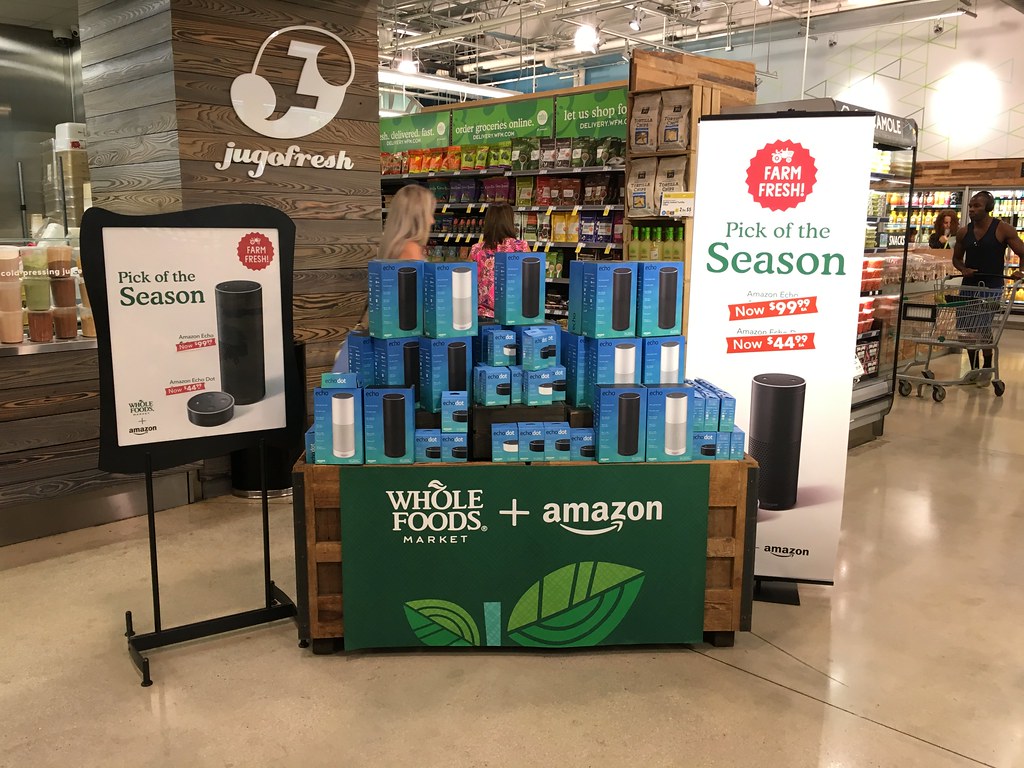Difference Between Amazon Fresh and Whole Foods Market
When it comes to foods and groceries, every little detail matters. From where the fruits and veggies are grown to the doorstep delivery of the products and from choosing the best quality produce to placing your order, it’s the little things that make up for a great grocery shopping experience. Thanks to the technological evolution and a steady rise of the Internet retailers that sell almost everything online, you can order your groceries and fresh fruits and veggies online, and have them delivered at your doorstep without even stepping out of your home. Fresh and seasonal are the hallmarks of today’s gourmet scene, and with online services like Amazon Fresh, you can even get your hands on the local farm produce and packaged foods totally cashierless.

What is Amazon Fresh?
Amazon Fresh is a grocery delivery and pickup service by the e-commerce giant Amazon headquartered in Seattle, Washington. Amazon works and coordinates with your favorite brands and local farmers to bring you the fresh fruits, veggies and groceries at your doorstep at a time that’s right for you. Amazon Fresh is available as a free trial or to Prime members allowing them to order from a vast selection of over 5,000 fresh fruits and veggies, dry grocery products, dairy products, fresh meat, packaged foods, and more. Members can also get special offers and discounts on select categories so that you can save on items that you’re looking for. Amazon Fresh is now available in almost all the major cities in the United States, Berlin, London, Hamburg, Tokyo, Singapore, Munich, Milan, and India. Users can sign in to their Prime account or use the Fresh app to place their order and get the products hassle free.

What is Whole Foods Market?
Whole Foods Market, based in Austin, Texas, is one of America’s largest chain of natural, plant-based foods stores. Whole Foods Market is probably the biggest player in the world of organic food chains. The supermarket chain sprouted from the opening of its first store in Texas in 1980 to operate 500 stores in North America and seven stores in the United Kingdom by 2019 by acquiring several natural foods store chains, including Mrs. Gooch’s Natural Food Markets of Los Angeles and Bread & Circus stores of New England. Whole Foods Market hit the mainstream at a time when organic food market was considered a pretty small niche kind of business. In 2017, the Ecommerce giant Amazon bought Whole Foods Market for $13.7 billion in cash, bringing one of the biggest names in the organic food market to its portfolio. The supermarket now sells Amazon devices like Echo and offers discounts for Amazon Prime members.
Difference between Amazon Fresh and Whole Foods Market
Model
– Amazon’s acquisition of the Whole Foods has opened up a new business for Amazon in the brink-and-mortar space. Whole Foods Market, based in Austin, Texas, will remain working as a separate unit of Amazon. Whole Foods Market is America’s third largest chain of natural, plant-based foods stores and one of the biggest players in the world of organic food market. Amazon Fresh, on the other hand, is a grocery delivery and pickup service by Amazon that allows you to order fresh fruits and vegetables, and groceries online, and have them delivered at your doorstep as per your schedule.
Market
– One of the major differences between the two retailers is that they target different consumer segments. Amazon Fresh works with your favorite brands and local farmers to get you local farm produce, fresh veggies and fruits, dairy products, and a wide selection of grocery items. Although, Amazon Fresh sells a lot of stuff, its main focus is groceries. Whole Foods Market, on the other hand, is a storefront for all things local and organic. Whole Foods Market sells a wide assortment of natural, plant based food products that are free from hydrogenated fats and unwanted additional preservatives.
Amazon Fresh vs. Whole Foods Market: Comparison Chart

Summary
Whole Foods Market is no longer a standalone brand since the popular supermarket chain was acquired by Ecommerce giant Amazon in a whopping $13.7 billion cash deal, which opens up a new market prospective for Amazon on the brick-and-mortar front. Whole Foods Market now operate under the ownership of Amazon as its separate grocery-shopping unit while keeping the core value of the brand intact, with a few additional offerings, such as special offers and discounts on the Whole Foods Market stores for the Amazon Prime members. It would appear the Amazon wants to keep the brand name for what it’s known for – a one-stop shop for all things organic and healthy – while building a relationship on trust and quality. This was a great move which would help grow the online grocery market for Amazon and expand its business with some of the biggest names in the grocery market under its portfolio, and not to mention brick and mortar presence.
- Difference Between Caucus and Primary - June 18, 2024
- Difference Between PPO and POS - May 30, 2024
- Difference Between RFID and NFC - May 28, 2024
Search DifferenceBetween.net :
Leave a Response
References :
[0]Wall, Benjamin. Amazon: Managing Extraordinary Success in 5-D Value. New York, United States: Morgan James Publishing, 2019. Print
[1]Dumaine, Brian. Bezonomics: How Amazon Is Changing Our Lives and What the World's Best Companies Are Learning from It. New York, United States: Simon and Schuster, 2020. Print
[2]DePamphilis, Donald. Mergers, Acquisitions, and Other Restructuring Activities: An Integrated Approach to Process, Tools, Cases, and Solutions. Amsterdam, Netherlands: Elsevier, 2019. Print
[3]Berg, Natalie and Miya Knights. Amazon: How the World’s Most Relentless Retailer will Continue to Revolutionize Commerce. London, United Kingdom: Kogan Page Publishers, 2019. Print
[4]Image credit: https://live.staticflickr.com/4404/36475628760_b619282122_b.jpg
[5]Image credit: https://live.staticflickr.com/3747/19595813310_34098c8009_b.jpg
